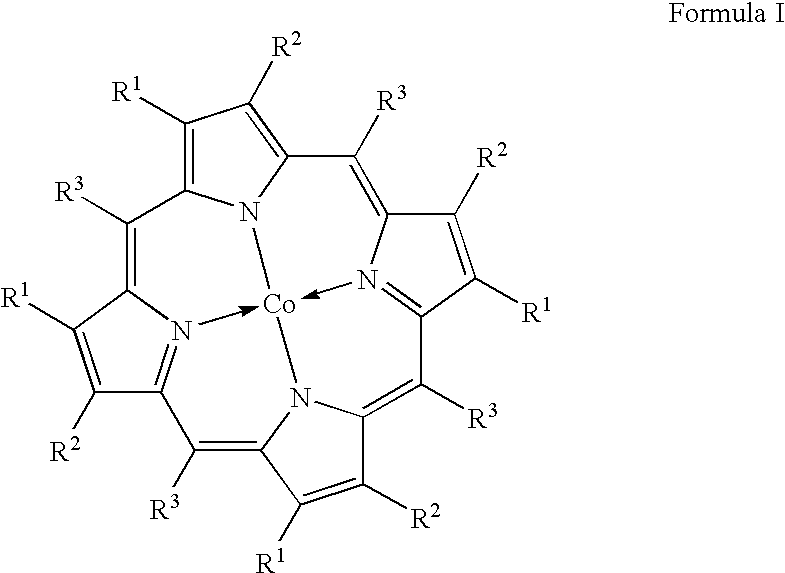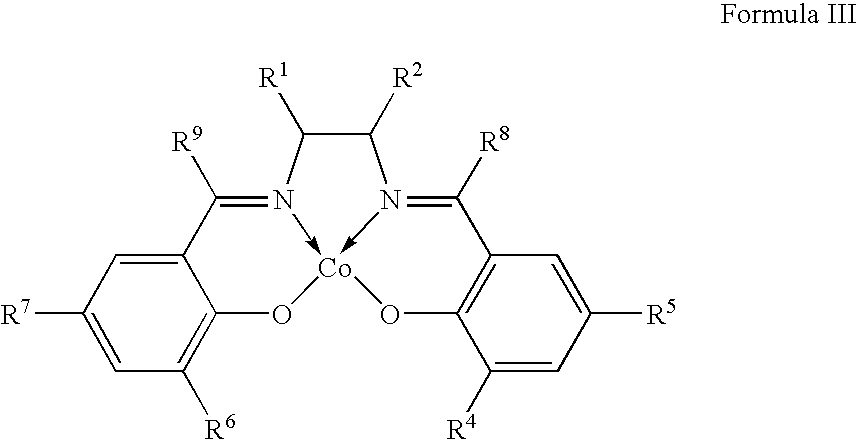One-step catalytic process for the synthesis of isocyanates
a catalytic process and isocyanate technology, applied in the preparation of isocyanate derivatives, isocyanate purification/separation, nitro-carbon monoxide reaction, etc., can solve the problems of high cost of phosgene substitutes. , to achieve the effect of efficient, safe and cost-effective one-po
- Summary
- Abstract
- Description
- Claims
- Application Information
AI Technical Summary
Benefits of technology
Problems solved by technology
Method used
Image
Examples
example 1
General Procedure for the Formation of a Schiff base-type Ligand Catalyst
[0079] An aldehyde is refluxed in the presence of the corresponding diamine (2:1 molar ratio) in ethanol 95%. Filtration and further washing with absolute ethanol afforded the essentially pure Schiff base-type ligand.
[0080] The Schiff base-type ligand obtained above is refluxed in an alcoholic solution together with an aqueous solution of Co(OAc)2. 4H2O under inert atmosphere. Although a crystalline precipitate immediately appeared, refluxing continues for about an hour. The precipitate obtained is filtered under vacuum, washed with water, ethanol and ether, and then dried under vacuum.
example 2
Immobilization of the Catalyst to a Solid Support
[0081] N,N′-(bis(3,5-di-tert-butyl-salicylidene)ethylenediamino)cobalt (II) [Co-tBu-Salen], 1.9 g, prepared following the procedure of Example 1, is added to 125 ml of 2-propanol with stirring, and the mixture heated to 70° C. Powdered silica (5 g, Grace Davison XPO 2407, specific surface area 250 m2 / g) is added to the solution and temperature and the stirring are maintained for a further 5 hours. The suspension is filtered, the solid residue is washed with 25 ml dichloromethane anhydrous, twice, and finally dried under vacuum for 5 hours.
example 3
Comparative Example
[0082] A mixture of the aniline (13.2 mmol), the cobalt complex [Co-tBu-Salen] (0.25 mmol) prepared following Example 1, NaI (2,72 mmol) and 1-butanol (20 ml) is charged in a 100 ml autoclave. The autoclave is flushed with carbon monoxide and oxygen in a volumetric ratio of 19 / 1 to a total pressure of 52.7 bar. The temperature is increased to 110° C. The reaction is maintained under constant vigorous stirring for three hours. After 3 hours the reactor is cooled to room temperature, depressurised and 97.8 g of 1,2-Dichlorobenzene (DCB) is charged in the reactor. The temperature is increased to 180° C. under atmospheric pressure. No 1-butanol is recovered by condensation of the vapours. Analysis of the reaction residue confirms the existence of urea derivatives but no traces of phenylisocyanate can be found.
PUM
| Property | Measurement | Unit |
|---|---|---|
| pressure | aaaaa | aaaaa |
| temperature | aaaaa | aaaaa |
| pressure | aaaaa | aaaaa |
Abstract
Description
Claims
Application Information
 Login to View More
Login to View More - R&D
- Intellectual Property
- Life Sciences
- Materials
- Tech Scout
- Unparalleled Data Quality
- Higher Quality Content
- 60% Fewer Hallucinations
Browse by: Latest US Patents, China's latest patents, Technical Efficacy Thesaurus, Application Domain, Technology Topic, Popular Technical Reports.
© 2025 PatSnap. All rights reserved.Legal|Privacy policy|Modern Slavery Act Transparency Statement|Sitemap|About US| Contact US: help@patsnap.com



